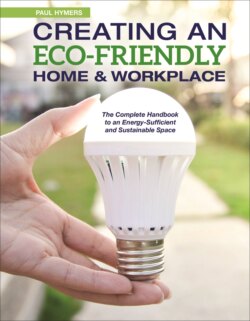Читать книгу Creating an Eco-Friendly Home & Workplace - Paul Hymers - Страница 36
На сайте Литреса книга снята с продажи.
Outdoor lighting
ОглавлениеMaking our gardens eco-friendly is not just about conserving water; conserving power in them has never been easier. Garden lighting needs to be just as carefully planned as lighting indoors so that the best features are revealed. Accent lighting that uses solar energy is an effective way to achieve this, but you will need to keep the lights low and fairly close to the subject. This should help to prevent light from spilling into other parts of the garden or your neighbours’ gardens and generally becoming a nuisance. Uplighting will be easier to achieve with low-energy spotlights of 3 to 5 watts, but sometimes even they will need a baffle or a shield of some kind to prevent the light from oversailing the object you are aiming it at. You can reduce the amount of spread laterally by choosing spots over floods, or by placing a tube (such as a short piece of drainpipe) over a ground lamp to baffle it.
Light pollution has left us living beneath an iridescent glow that covers the night sky, blanking out the stars. Starlight travels a long way to reach us, and it seems sad that after a journey of hundreds, if not thousands, of years, we blank it out in the last few seconds.
It became common to use 500 watt halogen floodlights on the walls of our homes with PIR detectors that scan half the garden and the adjacent pavement for movement. Besides the vast power drain they created, these lights did nothing to improve any home, and they have even been said to reduce security by providing too much glare. Think about it. Our pupils enlarge in the dark to see better and contract when they encounter bright light, which means that we see less in the dark shadows outside the pool of light. A 10 watt energy-efficient spotlight lamp, such as those in the LED range, is just as effective when positioned correctly. You can use them closer to the area you want to light and control the detection zone more tightly. To reduce glare, the angle of the beam should be below 70 degrees anyway, but the nearer to vertical it is, the better.
Internal PIR detector
Garden candles and solar powered table lamps are ideal if you have the room for them when you’re eating. Better still are the lights that can be clipped to the underside of a parasol.
You can use daylight sensors to switch on the lights at night, but they will remain on throughout the hours of darkness, so it is better to use a PIR detector to automatically switch the lighting on and off at times when it can be appreciated. There is no benefit in having outside lights turned on all the time.
With solar powered lights, at least there is no cost to having them on until the battery runs out, so it is worth looking for unique and interesting features in your garden to illuminate as well as the edges of pathways and drives. Look for shape and texture over colour, which beyond green will appear less than colourful under artificial light. What you really need is a striking subject with some structure to it. Plants described as ‘architectural’ are perfect.
